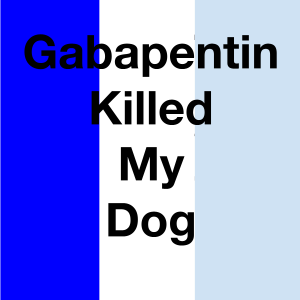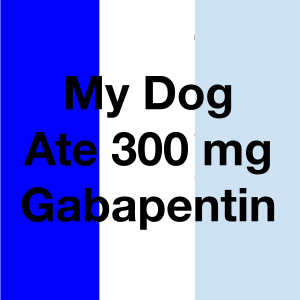
I lost a dog in tragic circumstances just over two years ago.
In the space of a week our dog went from being a seemingly fit and healthy 10 year old to having to be euthanized.
She died of a blood disorder and despite being in the vets for about three days, they couldn’t save her.
The vets tried everything and we were distraught and in shock.
We weren’t looking to blame anyone, it was just a set of tragic circumstances and we were still deeply traumatised by the experience.
And in this article, I want to walk you through some options and considerations if you think that your dog might have died after taking a drug called Gabapentin.
I will start off by giving you a short and concise answer before going into much more detail.
Can Gabapentin kill my dog?
Like any other prescription drug, Gabapentin can hurt a dog if it is used incorrectly.
It seems that the biggest danger to a dog is if the liquid form of the drug containing Xylitol is given to them.
Xylitol is an artificial sweetener which is used in the liquid form of Gabapentin.
It is highly toxic to dogs even in small amounts.
Apart from looking at the box that the medication was in (to confirm that it contained xylitol), you will then be looking for signs of poisoning in your dog.
These include vomiting, weakness and a lack of coordination and more serious cases can extend to seizures.
Even if you only suspect that you dog might have eaten some liquid Gabapentin, you should phone your local vets straight away.
Apart from the danger from Xylitol, a dog can be given too larger dose of the drug.
However, this isn’t thought to be life threatening as you dog will be more heavily sedated for longer.
What is Gabapentin?
Gabapentin is an FDA approved drug which is primarily prescribed to people to treat things such as epilepsy and nerve pain.
It is also used to treat dogs for things like seizures, pain and anxiety.
Medications that are primarily designed for use by humans but which are also used to treat dogs are described as “off label” because they weren’t originally created to be used with dogs.
What brand names is it also known by?
Gabapentin is also known as Neurontin, Aclonium, Equipax, Gantin, Gabarone, Gralise, Neurostil and Progesse.
How is Gabapentin administered to dogs?
Gabapentin comes in three forms-capsule, tablet or liquid.
It should be given to your dog just before some food because some dogs who are given this drug on an empty stomach could vomit.
Gabapentin and Xylitol- a warning
Never give your dog Gabapentin in liquid form.
The reason for this is that it contains Xylitol which is an artificial sweetener which is toxic to dogs, even in quite small doses.
The reason that xylitol is used in gabapentin is to make it taste sweeter and more palatable.
Xylitol is used in quite a lot of human medications for this very reason.
What is the dosage for Gabapentin?
Tablets and capsules come in three sizes: 100 mg, 300 mg and 400 mg.
Since Gabapentin can be used to treat seizures, pain and anxiety, the dosage will vary.
It will depend on what the drug is being used to treat and the size of your dog course.
However, this reputable source provides us with a range.
That between 4.5 and 9 mg per lb of body weight be used.
Some dogs will be too small to use even the 100 mg tablets and so they will need a specialist dog pharmacy to prepare the right dose for them.
How long does Gabapentin act and how long will a dose last?
Gabapentin should start to take effect within a couple of hours and then within 24 hours any effects will wear off.
What are the side effects of Gabapentin?
The most common side effect from a dog taking Gabapentin is that they become drowsy and sedated.
But the effects of over sedation can be compensated by giving lower doses of the drug going forward.
Other than that, other common side effects seem to be mild.
Like a mild case of diarrhea.
What factors should be considered before taking Gabapentin?
This drug should be used with caution when being used with dogs who have liver or kidney disease because the drug will take longer to metabolise.
Another risk factor is in stopping its use too abruptly when using it with dogs who are epileptic.
This is because stopping the medication too quickly can trigger an epileptic fit.
Can it be used with any other medication?
This drug is commonly used with other opioids or NSAIDs.
It is thought that Gabapentin enhances the effect of those medications
When used to treat anxiety, Gabapentin can be used with Trazodone.
But there are a few medications that Gabapentin should not be used with.
These include Tramadol, antacids (such as Tums) hydrocodone or morphine.
Are there alternatives to Gabapentin?
There are alternative medications that can be used to treat pain, seizures and anxiety in dogs.
Amantadine is an alternative when it comes to treating chronic pain in dogs.
And a natural alternative for this could be CBD oil although there has been very little research into how effective this oil is in treating pain.
In terms of drugs that are used to treat seizures in dogs, two drugs are licensed for this. A phenobarbital called Epiphen and Imepitoin or Pexion.
My dog ate Gabapentin. What should I do?
Because Gabapentin is a human medication, you might be in a situation where your dog has accidentally eaten your supply of Gabapentin.
The most worrying situation is if your supply of Gabapentin is in liquid form and contains xylitol
This is highly toxic to your dog.
As we have discussed previously, if you take this drug in tablet or capsule form then your dog will probably be OK because it is very hard to overdose to such an extent where your dog will die.
However much of the drug that your dog has eaten, you should phone the vet and let them know approximately how much of the drug has been eaten.
What to do if your dog died from a Gabapentin overdose?
The first thing you can do is to take an autopsy of your dog. Though this may be difficult, it is one of the best ways to determine the exact cause of their sudden deaths. Causes of death can indeed be Gabapentin, or other factors such as underlying health issues aside from heart failure or a toxic environment may very well contribute to the cause of death.
If Gabapentin turned out to be the true cause of death, you could file a complaint to the drug company that manufactured the Gabapentin prescribed. Ensure you have all the medical records and documentation of events that occurred before their sudden death. To file a report on severe drug cases, check out the FDA to report a serious medical product problem.
Should you consider suing your vet?
Suppose you believe or suspect that your vet has made a mistake and harms or kills your dog due to carelessness or negligence. In that case, this counts as veterinary malpractice. There are a couple of ways to deal with this, which include:
- Sending a complaint to your state veterinary licensing board, as the board has the authority to suspend or revoke a vet’s license.
- Sue the vet in a court of law
- Negotiate for a settlement or bring a lawsuit with a lawyer’s assistance
- Pursue your case in a small claims court. Though you don’t have to hire a lawyer for this, the compensation or money return you get is relatively smaller than in other courts.
A civil lawsuit is usually the recommended option by most lawyers when going against veterinary malpractice. Below are the steps of how the stages occur:
- The plaintiff files a complaint to initiate the lawsuit
- The defendant files an answer to the filed complaint
- The judge in charge will issue a scheduling order with a timeline of important dates and deadlines, including the date and time of trial.
- Both parties engage in discovery (exchange of relevant information), so ensure all records are in place and ready.
- Motions and other pleadings can be filed
- A jury will then be selected to start the trial
- The jury will then make a decision
- Either party may appeal the decision
Veterinary malpractice claims have been relatively low in the past, but laws are currently changing to turn that around. Some courts are gradually recognizing that an animal is unique and is irreplaceable. Hence courts are starting to allow more significant compensations with respect to the animal’s intrinsic value, aside from their economic value.
Pet bereavement services and support groups
Dealing with the loss of your beloved companion is one tough pill to swallow, but it doesn’t mean you should go through it alone. Pet bereavement services provide a safe space where you can connect with other pet owners who have gone through the same thing you have and talk about it (it really helps). Here are some resources to help:
Rainbowsbridge offers a forum and a chat room open 24 hours with caring volunteers between 8 and 12 pm EST ready to help you out for more personal contact with those who have also lost their furry friends.
Lap of Love offers pet loss support groups and organizes weekly sessions on Zoom throughout the week led by their Pet Loss Support Team. Here is where you can find yourself in a safe and compassionate space to listen and share each other’s stories and help one another through loss.
Another is the Pet Loss Support Group that you can find on Facebook. The group was created and led by Anne. She is a professional grief counselor with over 30 years of experience with a Master’s in Counselling Psychology and a certified trauma specialist.





